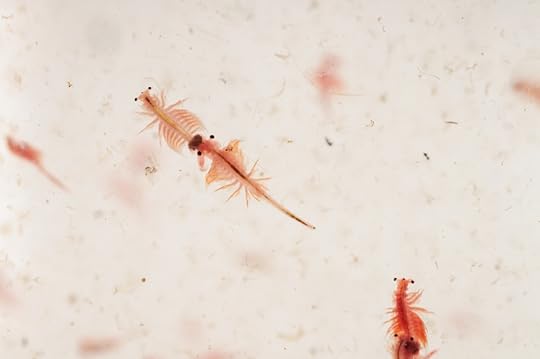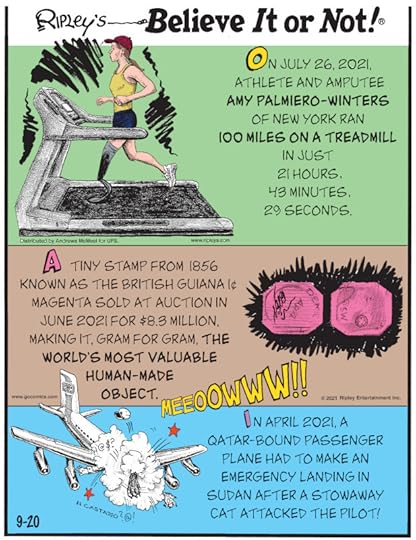Ripley Entertainment Inc.'s Blog, page 125
September 22, 2021
Can You Solve Cain’s Jawbone: The (Nearly) Impossible Literary Puzzle?
Featured in Ripley's Believe It or Not!

Cain’s Jawbone is a literary puzzle and murder mystery that has been around for 90 years and, after all these years, only three people have ever solved it. It was devised in 1934 by English poet and cryptic crossword compiler Edward Powys Mathers, who wrote under the name Torquemada, and consists of 100 pages from his 1934 collection The Torquemada Puzzle Book. Powys Mathers claimed the pages were printed “in an entirely haphazard and incorrect order” and wrote that it was too late for him to remedy the ordering of the pages.
Therefore, the reader’s goal is to put the pages back in the correct order and figure out who kills who in the book. In total, there are six murders, which means six victims and six murderers? Or could there only be one perpetrator? You’ll have to put on your best crime-hunting hat and channel your inner detective to find out.
Cain’s Jawbone (named for the first murderer and his weapon), first appeared in 1934 at the back of The Torquemada Puzzle Book: It’s a whodunit, accidentally bound in an ‘incorrect order’ The reader was invited to reorder the pages correctly to reveal the six murderers. pic.twitter.com/7CDpGatZuN
— Mathew Clayton (@Mathew__Clayton) November 6, 2020
There are 32 million possible combinations, and if you’re able to put the story together in the correct order, you win a reward of $1,335. At this rate, they should probably give the next lucky puzzle solver a raise!
The first two individuals to solve the puzzle were Mr. S. Sydney-Turner and Mr. W.S. Kennedy who sent their solutions to The Observer. Upon being announced correct, they received their cash prize and recognition in the paper.
It had been reported by The Guardian’s Alan Connor that the answer to this literary puzzle was thought to be gone forever. But just when they thought there was no hope, Laurence Sterne Trust, administrators of Shandy Hall, a historic museum in Geneva, Ohio, received a copy of The Torquemada Puzzle Book. This prompted Patrick Wildgust, one of the museum’s curators, to work quickly to see if they were able to uncover the solution to the puzzle.
Incredibly, they were able to confirm the solution with one of the two previous puzzle solvers. Answer in hand, Shandy Hall partnered with the publisher Unbound to re-issue Cain’s Jawbone in autumn of 2019. Powys Mathers’ secret was safe with the museum. They allowed those inquisitive enough to take a stab at the puzzle to do just that. Twelve people came back with what they believed was the right answer and only one was actually correct.
That person was British comedy writer John Finnemore. Quarantine was a time of puzzles, games, and figuring things out, so Finnemore took it upon himself to dive deeper into the infamous Cain’s Jawbone while he had some extra time on his hands. He did some online research to make a bit more sense of the novel’s plot and dug deep for any literary references he could find. Although, he came up with nothing. After a bit of defeat and a mere four months, Finnemore finally solved the puzzle.
Powys Mathers, your secret is now also safe with Finnemore, one of the few people alive who know the true answer. Wildgust also is sworn to secrecy. We challenge you to be the next to solve this so-called “impossible” puzzle. Proceed with caution, as it’s been reported that this puzzle is extremely difficult and not for the faint-hearted. Good luck!
By Sam McCormack, contributor for Ripleys.com
EXPLORE THE ODD IN PERSON! Discover hundreds of strange and unusual artifacts and get hands-on with unbelievable interactives when you visit a Ripley’s Odditorium!Source: Can You Solve Cain’s Jawbone: The (Nearly) Impossible Literary Puzzle?
CARTOON 09-22-2021
September 21, 2021
The Quietest Place in America
Featured in Ripley's Believe It or Not!

There’s an area in West Virginia that regulates the use of cell phones, wireless internet, and other devices that use electromagnetic waves, and it’s considered the quietest place in the United States. The reason why the town of Green Bank has a National Radio Quiet Zone (NRQZ) put into place by the federal government is because it is home to an observatory.
The Green Bank Observatory (GBO), formerly known as the National Radio Astronomy Observatory (NRAO), was built in 1957 and features eight telescopes, including the Robert C. Byrd Green Bank Telescope—the largest fully steerable radio telescope on Earth. This gigantic telescope is 300 feet in diameter and weighs nearly 17 million pounds.

Editorial credit: Malachi Jacobs / Shutterstock.com
The Federal Communications Commission created the NRQZ in 1958 to block potentially detrimental interference at the NRAO, as well as at the U.S. Naval facilities in nearby Sugar Grove. This zone covers 13,000 square miles in Virginia and West Virginia.
Living in a radio-quiet environment makes life in this part of the country a little different from the rest of the United States. For example, there’s a general store in Arbovale in which customers leave sticky note messages for their friends and family on two conveyor belts, according to the New York Post. And those who live on the GBO site cannot use cell phones, cordless phones, Wi-Fi, microwaves, or even wireless speakers, reports resident Marilyn Creager. That’s because these types of devices can create interference with radio astronomical observations.
Embed from Getty Imageswindow.gie=window.gie||function(c){(gie.q=gie.q||[]).push(c)};gie(function(){gie.widgets.load({id:'kOg_sDj9SE93dIA8akFAPg',sig:'Lzh5UUcohkyU0BYkUhPbsU_3wuYpGOgXqH488Mb9NV0=',w:'594px',h:'415px',items:'982398166',caption: true ,tld:'com',is360: false })});
The Quiet Zone is an appealing place for survivalists and those who claim to be sensitive to electromagnetic devices. Many of these people move to Green Bank and the surrounding area to avoid the digital footprint that’s so prominent in most areas of the country. In addition, it’s a way for them to avoid some forms of modern technology. Some individuals are there because they feel their health is suffering from electromagnetic radiation. Many flock to the area simply because they don’t want anyone to bother them.
But there’s also a positive component to the radio-quiet zone. For example, since the residents don’t use cell phones, many substitute HAM radios and are on scene to help with an incident even before law enforcement responds. You won’t see any car accidents caused by drivers distracted by texting. It’s also not unusual to see phone booths and people using paper maps instead of GPS to navigate, according to the New York Times.
Embed from Getty Imageswindow.gie=window.gie||function(c){(gie.q=gie.q||[]).push(c)};gie(function(){gie.widgets.load({id:'GXJw1pYIQ81VUFgPAnMQwg',sig:'kJxjsbQgOSCOqGrRdtoNZ9vmuqfUgYW5MSa1F4vTfZ0=',w:'594px',h:'414px',items:'982398306',caption: true ,tld:'com',is360: false })});
Locals like living in the NRQZ and surrounding area because it allows them to disconnect from devices and connect to nature, each other, and a simpler way of life. Instead of spending time online, they spend time outdoors and with people in person. It’s a quieter way of living in an increasingly connected world that can be very noisy at times.
By Noelle Talmon, contributor for Ripleys.com
EXPLORE THE ODD IN PERSON! Discover hundreds of strange and unusual artifacts and get hands-on with unbelievable interactives when you visit a Ripley’s Odditorium!Source: The Quietest Place in America
CARTOON 09-21-2021
September 20, 2021
CARTOON 09-20-2021
September 19, 2021
CARTOON 09-19-2021
September 18, 2021
CARTOON 09-18-2021
September 17, 2021
Bearded Protection And Cat Communication Win Ig Nobel Prizes
Featured in Ripley's Believe It or Not!

This week marked the return of science’s weirdest night out as Improbable Research hosted their 31st Annual Ig Nobel Prize Awards!
Every year, scientists worldwide gather at Harvard University’s Sanders Theatre for the Ig Nobel Prize Ceremony, celebrating scientific research that makes you laugh while you think.
Last year’s winning research ranged from the useful discovery that narcissists can be identified by their eyebrows to the seemingly less practical, albeit interesting, invention of a poop knife, leaving this year’s contenders with big shoes to fill.
Hosted virtually for the second year in a row, this year’s ceremony recognized scientists searching for answers to some of the world’s strangest mysteries, including the best way to transport rhinos, why beards became a trend, and just how gross sidewalk gum really is.
Read on to learn more about some of our favorite winners. You just may find answers to some questions you didn’t even know you had!
Chew WiselyResearchers Leila Satari, Alba Guillén, Àngela Vidal-Verdú, and Manuel Pocar of Spain’s University of Valencia were awarded the Ecology Prize for their work in identifying the microbiome of sidewalk gum.

The Spanish and Iranian scientists pounded pavement across the world, collecting chewed-up gum from sidewalks to study the difference in bacteria from a fresh wad vs. that of one stuck to the ground for up to three months.
Their results will come as no surprise to anybody who has had the displeasure of stepping in someone’s mouth litter: it’s pretty nasty.
While fresh gum features mainly strains of human oral bacteria, it eventually adapts to the bacteria of its surroundings. The outcome offers much more to the world than its gross-out factor, though.
“Our findings have implications for a wide range of disciplines, including forensics, contagious disease control, or bioremediation of wasted chewing gum residues,” revealed the researchers in their study, as published on Nature.com.
Sticky gum spitters beware; we’ll be able to find you soon enough.
Soften the BlowThe Ig Nobel Peace Prize winners took their prize to the face after testing their hypothesis that beards are for more than just looks.

University of Utah scientists Ethan Beseris, Steven Naleway, and David Carriers launched a study to determine whether having a mane on your face serves a greater purpose than hiding an unfortunate jawline.
Since their team couldn’t exactly go around punching men in the face to test their theory, they used a fiber epoxy composite in place of human bone and sheepskin as human skin. They compared what happened when they dropped a 4.7-kilogram weight on the sheepskin when fleeced vs. sheared.
The fleeced sample fared much better than the sheared, supporting their hypothesis that a face mane may protect the facial skeleton itself.
Walk the WalkWe’ve all been there — that awkward almost run-in with a complete stranger, often leading to a varying degree of embarrassing small talk about dancing. We almost missed these cringeworthy exchanges over the past year, and so, it seems, did the Ig panel.
Both the Physics and Kinetics Prizes were awarded to the study of how pedestrians stay in their own lane.
Alessandro Corbetta, Jasper Meeusen, Chung-min Lee, Roberto Benzi, and Federico Toschi of the Netherlands, Italy, Taiwan, and the U.S. joined ranks to conduct experiments to learn why these exchanges don’t happen even more frequently.
The team rigged sensors in Eindhoven railway spaces to study how pedestrians in mass transit areas avoid colliding.
Meanwhile, Kinetics winners Hisashi Murakami, Claudio Feliciani, Yuta Nishiyama, and Katsuhiro Nishinari of Japan, Switzerland, and Italy tested the flip side of the coin, studying how smartphones contribute to pedestrian run-ins.
The outcome was fairly predictable, with fewer collisions occurring when people were actually paying attention instead of scrolling on their phones.
Interestingly, Hisashi, who led the research, doesn’t even own a smartphone. However, he can relate to the struggle of the distracted, as he has been guilty of reading a book while walking.
Flying RhinosThe prize for Transportation was awarded to a team committed to ensuring the most comfortable mode of rhinoceros travel.
Robin Radcliffe, Mark Jago, Peter Morkel, Estelle Morkel, Pierre du Preez, Piet Beytell, Birgit Kotting, Bakker Manuel, Jan Hendrik du Preez, Michele Miller, Julia Felippe, Stephen Parry, and Robin Gleed made up the international team responsible for posing the question: are rhinos safer when airlifted upside down?
Led by Radcliffe, a senior wildlife and conservation medicine lecturer at Cornell University, the team initially assumed the outcome would show that hanging them upside down would not be in the rhinos’ best interest. However, after sedating, binding, and suspending 12 black rhinos in the air, they found that the animals’ blood oxygen levels were much better than the other common method of placing them on their sides on a stretcher hanging from a helicopter.
The findings of this experiment have important implications for conservationists, as rhinos are often moved around Africa to promote the diversity of their gene pool, ensuring a longer existence for the species.
The Cat’s MeowIt’s no secret that cats are a total mood and will let you know when they want something — and when they want to be left alone.
Swedish researchers and cat lovers Susanne Schötz, Robert Eklund, and Joost van de Weijer set out to understand what each hiss, purr, chirp, and meow means, ultimately earning the Biology Ig Nobel Prize for their study.

After observing and listening to cats for hours on end, the team was able to conclude that while cats across the board do not have a specific language, they do have individual voices and often develop a “group dialect.”
“They listen to what other cats are saying to get what they want, and they adopt those successful sounds,” Schötz explains.
It also turns out that they can sing, with Schötz noting that “the more variation in the melody, the more excited or urgent the message seems to be.”
Meow-sic to our ears!
Needless to say, weirdness knows no bounds when it comes to the Ig Nobel Prize awards! Be sure to check out the full list of winners at Improbable Research’s website, and keep us posted with your strangest discoveries — you never know what may come of them!
By Meghan Yani, contributor for Ripleys.com
EXPLORE THE ODD IN PERSON! Discover hundreds of strange and unusual artifacts and get hands-on with unbelievable interactives when you visit a Ripley’s Odditorium!Source: Bearded Protection And Cat Communication Win Ig Nobel Prizes
The Sorcery Behind Sea-Monkeys
Featured in Ripley's Believe It or Not!

There was once a time when no child could flip through Highlights 0r other magazines without seeing a piece of cut-out collateral featuring the toy-pet hybrid known as Sea-Monkeys! Let’s dive a little deeper into the magic of suspended animation and the species of brine shrimp known as Artemia salina.
Sea-Monkeys and Suspended AnimationBack in 1957, a man named Harold von Braunhut became fascinated with a species of brine shrimp that were commonly sold as a source of pet food. Known as Artemia salina, this particular species thrives in salt lakes or salt flats. With the evaporation of the water in these areas, the tiny shrimp are left with nothing but a high-sodium diet to survive, causing them to move into a state of “suspended animation.” In a process known as cryptobiosis, the shrimp are encased in a cyst-like protective coating (basically, a dehydrated shell). When water is added to this shell, the shrimp could be revived.

Eager to make a little bang for his buck, von Braunhut experimented with these creatures and figured out a way to mix nutrients with average tap water, thus creating an elixir of life for these dried brine shrimp. This process would allow for people to take home the shrimp and, essentially, “grow them” on their own!
A Bowl Full of HappinessDuring the product’s 1960s debut, von Braunhut was selling these kits for only 49 cents a pop! Under the name “Instant Life,” each set of supplies included a packet of shrimp and a packet of nutrients for them to eat. All you had to do was provide a tank or living space and fill it with water.
Marketing this life in a bag as a “bowl full of happiness,” von Braunhut found great success in his brine goldmine. He worked out of his self-made factory (aka his barn) to assemble orders and try to find retailers willing to pick up his idea to sell. When he was essentially denied from all the big-box toy brands at the time, he took matters into his own hands.
Rather than opt for the expensive and flashy television commercials others had been using, von Braunhut went straight to the eyes of his juvenile target market. He took out numerous ads in comic books. And to make money-making even easier, all kids had to do was send the cash to the address in the ad and their Sea-Monkeys would show up at their doorstep.
To further advertise the potential of this glorified pet food, von Braunhut hired “Sea-Monkey artists” to help him illustrate the many possible roles of these little guys to their owners. His team of talented illustrators depicted the Sea-Monkeys as magical beings — little monkeys with fish-like bodies and crown-like heads. He also depicted them performing all kinds of unique talents and skills like playing baseball and getting hypnotized!
Robert Ripley’s Living MonstersActually, von Braunhut wasn’t the only one embellishing the feats of these little swimmers! Believe It or Not!, Robert Ripley joined in on this whole fad, and added a Ripley’s spin of course. Not only could you grow your own Sea-Monkeys in their very own Sea-Circus Aquarium, but you could also opt for growing your own Living Monsters!
But the not-so-magical part of von Braunhut’s living toy that kids were quickly discovering is just how short of a lifespan their new Sea-Monkey family actually had. But don’t worry, he had a solution for that too!
Super Sea-MonkeysVon Braunhut set out to create a new hybrid of the brine shrimp known as “Super Sea-Monkeys!” He recruited the help of microcrustacean expert and marine biologist, Anthony D’Agostino, to take his current revival process to the next level. The two created a new, more durable breed of shrimp they called Artemia NYOS. Forget a few days — now your Sea-Monkeys were set for “life!” Well, let’s use the term “life” rather loosely. There’s no real scientific evidence behind this new hybrid living much longer or growing much larger than the original species of brine shrimp that von Braunhut started with.
The Elixir of LifeSo, what exactly is the elixir of life that allows for Sea-Monkeys to really grow? When you snatch a packet of Sea-Monkeys off the shelf, you’ll discover a few different pouches inside. One pouch, which seemingly looks like a powder, is actually the lifeless colony of Sea-Monkeys. Pouring this pouch into the water will start their new life. Over the next few days and weeks, add your other pouches to the water — this is the Monkeys’ diet: yeast and spirulina.
View this post on Instagram
A post shared by The Original Sea-Monkeys® (@theoriginalseamonkeys)
Slowly, these little swimmers will begin to sprout and mature. They start life with one eye but pop out two additional eyes upon reaching maturity. They also are quite see-through and actually use their “feet” to breathe. Plus, they’re capable of both sexual and asexual reproduction, which means, regardless of how many males or females you have in there, expect your Sea-Monkey fam to grow!
Did you grow up with a Sea-Monkey kingdom of your own? Tell us the tricks of the trade to keeping these shrimp alive by dropping us a comment or direct message on Instagram!
EXPLORE THE ODD IN PERSON! Discover hundreds of strange and unusual artifacts and get hands-on with unbelievable interactives when you visit a Ripley’s Odditorium!Source: The Sorcery Behind Sea-Monkeys
CARTOON 09-17-2021
Ripley Entertainment Inc.'s Blog
- Ripley Entertainment Inc.'s profile
- 52 followers









